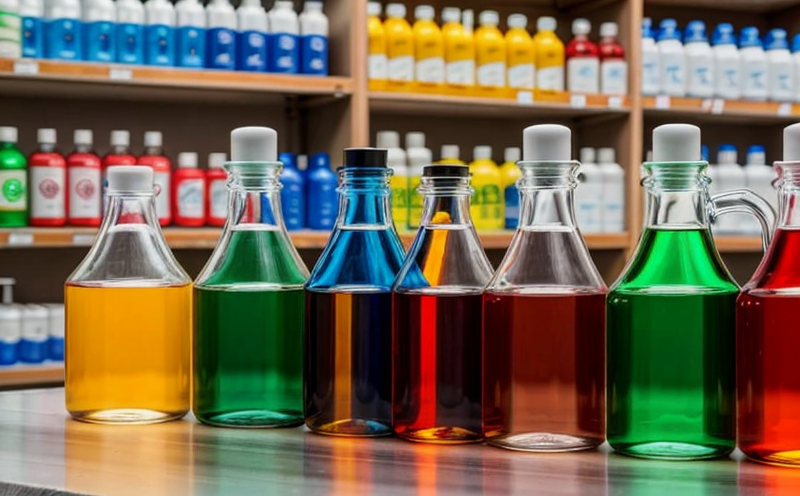AATCC 112 Formaldehyde content testing in textile fabrics
The AATCC Test Method 112 is a globally recognized standard used to measure formaldehyde release from textile fabrics. This test ensures that textiles comply with safety regulations and are suitable for consumer use, particularly regarding skin contact products like clothing, bedding, and upholstery.
Formaldehyde can be added intentionally during the manufacturing process or released as a by-product of chemical reactions involving certain dyes and finishes. The AATCC 112 test aims to quantify this formaldehyde content, thereby helping manufacturers ensure compliance with regulatory requirements such as Oeko-Tex Standard 100.
The testing procedure involves subjecting textile samples to a series of controlled conditions designed to simulate real-world use scenarios. This includes exposing the fabric to heat and moisture, which can enhance the release of formaldehyde from the material. The released gas is then captured and analyzed using advanced analytical techniques such as gas chromatography (GC).
Understanding the formaldehyde content in textiles is crucial for several reasons:
- To ensure product safety and prevent adverse health effects on consumers
- To comply with international regulations and industry standards
- To maintain brand reputation by providing high-quality, safe products
- To enhance consumer confidence through transparency in product labeling
The test results provide valuable insights into the potential risks associated with prolonged contact of textiles containing formaldehyde. This information is essential for quality managers and compliance officers to make informed decisions about production processes and material selection.
For R&D engineers, this testing method offers a platform to innovate safer textile finishes and treatments while ensuring product performance remains unaffected. Procurement teams can leverage these test results to source materials that meet strict formaldehyde emission limits, thereby reducing the risk of non-compliance issues down the supply chain.
Frequently Asked Questions
Why Choose This Test
The AATCC 112 formaldehyde content test is an indispensable tool for quality managers, compliance officers, R&D engineers, and procurement teams. By ensuring that textile products meet stringent safety standards, this test helps protect the health of consumers while maintaining brand integrity.
- Ensures Regulatory Compliance: The test adheres to international standards such as Oeko-Tex Standard 100, guaranteeing that textiles comply with strict formaldehyde emission limits.
- Promotes Consumer Safety: By detecting and quantifying formaldehyde release from fabrics, this test reduces the risk of skin irritation and other health issues associated with prolonged exposure to high levels of formaldehyde.
- Enhances Brand Reputation: Companies that invest in rigorous quality control measures like AATCC 112 testing can build a positive brand image, fostering consumer trust and loyalty.
- Supports Innovation: R&D teams can use the insights gained from this test to develop safer, more sustainable textile finishes without compromising product performance.
The reliability of AATCC 112 results is further bolstered by its widespread acceptance in the industry. This global recognition ensures that manufacturers and suppliers can confidently market their products as compliant with international standards.
International Acceptance and Recognition
The AATCC Test Method 112 has been widely adopted across various industries and regions, making it a crucial tool for ensuring the safety of textile products. Its acceptance is particularly significant in markets where stringent formaldehyde emission limits are enforced.
One of the key benefits of using this test method is its alignment with international standards such as Oeko-Tex Standard 100 and ISO 3548:2009. Compliance with these standards not only facilitates market access but also demonstrates a commitment to environmental responsibility and consumer safety.
Manufacturers who comply with AATCC 112 are better positioned to meet the expectations of regulatory bodies, retailers, and consumers globally. This test method ensures that textiles meet not only local regulations but also those imposed by international markets, thereby minimizing the risk of non-compliance penalties and reputational damage.
The global acceptance of AATCC 112 is further underscored by its consistent application across different types of textile products, from clothing to home furnishings. This versatility makes it an essential tool for businesses operating in diverse sectors such as fashion, furniture manufacturing, and interior design.
Environmental and Sustainability Contributions
The AATCC 112 formaldehyde content test plays a crucial role in promoting environmental sustainability by ensuring that textile products are safe and non-toxic. By reducing the risk of health hazards associated with formaldehyde exposure, this testing method contributes to a healthier environment.
- Reduces Environmental Impact: Ensuring that textiles meet formaldehyde emission limits helps minimize the ecological footprint of manufacturing processes. This is particularly important in industries where large-scale production can lead to significant environmental degradation.
- Promotes Safer Workplaces: By reducing the need for stringent occupational health and safety measures, this test supports more sustainable work environments. It allows manufacturers to maintain a balance between productivity and worker well-being.
- Fosters Sustainable Consumption: Consumers are increasingly seeking out environmentally friendly products. Compliance with AATCC 112 helps companies meet these expectations, thereby encouraging responsible consumption patterns.
The use of this test method also supports the development of more sustainable textile manufacturing practices. By identifying and addressing formaldehyde emissions early in the production process, manufacturers can adopt greener technologies and processes that reduce waste and energy consumption.
Moreover, compliance with AATCC 112 fosters a culture of continuous improvement within the industry. As regulatory standards evolve, businesses that prioritize testing methods like this one are better equipped to adapt and innovate, ensuring long-term sustainability in their operations.





